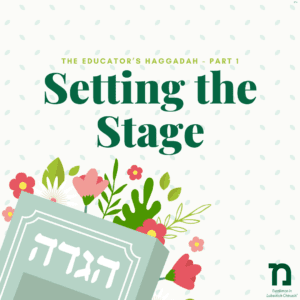The entire purpose of the Pesach Seder is Chinuch – V’higad’ta Livincha. Every step, carefully crafted and placed in the Seder, holds wisdom for educators to take with them for their holy task throughout the year. Here are just a few such Chinuch nuggets gleaned from the Simanei Haseder.
- Kadeish – Relationship First
The opening of the Hagada sets the tone for the whole night. It provides the context, the backdrop, in which the rest of the Seder will unfold. It establishes the relationship.
Kadeish, Kedusha, and Kiddush all connote making something designated, special, and apart.
Kadeish is like the threshold routine in the classroom. It’s stepping into a sacred space where the teacher cares about the students, and the students appreciate the teacher and are ready recipients for what he has to offer. Kadeish is when we say, why are we even here?
In the Rebbe’s words, written to a teacher:
ועיקר העיקרים שבזה הוא… יחס מיוחד והתקשרות, שזהו הצנור הכי מתאים להחדרה בהילדים אהבת ה’ אהבת התורה ומצותי’. (אגרות קודש כ״ק אדמו״ר, חי״ג ע׳ תכד)
“The primary foundation is that… a special connection and relationship [with students]… is the most appropriate means for imbuing children with Ahavas Hashem, and love of Torah and Mitzvos.”
Never tire of telling your students, or children, how much you care about them, how strong your connection is, and how special this space that you share. Especially at the beginning.
- Urchatz – Daily Halacha
At the beginning of the Seder, we do something simple, but exciting – exciting because it is unusual, and so many of us get it wrong. My children come into the kitchen singing, “Mommy don’t make a Bracha, Tatty don’t make a Bracha, Berel don’t make a bracha,” etc. as we wash. I myself have been guilty of automatically reciting the bracha, and then having to complete the Seder out of order (gulp) more than once.
But is this washing without a bracha so unusual?
The reason for this part of the Hagada is not esoteric symbolism, but every day Halacha!
Before eating a fruit and vegetable that is wet or going to be dipped in liquid, if it is something eaten with our hands – a finger food – we’re meant to wash. Rachtza can take place every day, and it takes place here because we are about to dip the Karpas into saltwater.
This is something that I never knew about until Morah Korf’s Halacha classes in Bais Rivkah, but perhaps Rachtza in the context of Chinuch is a reminder to emphasize daily Halacha. המעשה הוא העיקר – before delving into the depths of the Hagada, practical Halacha comes first. As the Rebbe emphasized:
“It is surprising that …there is no class for learning the Halachos that are necessary in day-to-day life. The lack of knowledge in this area is alarming, despite the fact that knowledge specifically in this area is most necessary…. If I had the power, I would establish the learning of these subjects in all Chinuch institutions beginning in kindergarten and concluding in Yeshivos and Kollel.” (“Teachings of the Rebbe on Chinuch” by Rabbi Nochum Kaplan, Page 310-311; translated from Igros Kodesh, vol. 10, p. 130; Igros Kodesh, vol. 10, p. 270)
- Karpas – Emotional Intelligence
Chassidism are all about Simcha. Later on in the Seder, we will sing and exult, retelling the miracles that happened in Yetzias Mitrzayim. But first, we dip our Karpas in saltwater, to taste the bitter tears. Why?
Many people are under the misconception that the Chassidus emphasis on joy – “tracht gut vet zain gut,” and “simcha poiretz geder,” means ignoring and negating any sadness and pain and skipping right to the Simcha. However, the more a person is cognizant of the suffering, the more joy they then feel over their redemption from that pain – whether it took place already, or whether they are looking forward with staunch Bitachon to its coming.
We learn this from Miriam Haneviah. Her name means bitterness, because as a woman and mother, she felt the pain of Galus Mitzrayim deeply. Yet, it is precisely Miriam who was able to transform this pain into celebration at Kriyas Yam Suf, leading the women in dancing with their prepared tambourines. In fact, the women are praised for celebrating in a way that was superior to the men, who perhaps did not feel the suffering as much and therefore felt less joy at their salvation.
As educators, it is important to recognize our role in teaching students about emotions. When we say, “Don’t cry,” “Just be happy,” or otherwise try to erase any sadness with the snap of a finger, we teach children not to trust themselves, and inadvertently put a cap on their inner fount of emotions – which includes positive emotions as well. Instead, we pause, like dipping the Karpas into saltwater. “You feel down? Let me sit with you and hear more. Then, we can try to find the good in the situation, or strengthen our Bitachon that in fact it will all turn out well.”
A rich emotional life lends itself to passionate Tefilla, closeness with fellow Yidden, and enthusiastic observance of Torah and Mitzvos. A Beinoni is not a robot – he is aware of his emotions, and responds and channel them in the right way. As the Rebbe explains (and as elaborated upon at length in the book “Letters for Life,” by Rabbi Levi Shmotkin), “moach shalit al halev – the mind ruling over the heart” means two things: one, that the mind must illuminate the emotions and guide them appropriately, and two, that the heart is also valuable and needs to find expression in a Chassid’s avoda.
- Yachatz – Broken and Whole
With Yachatz, we further pique our children’s interest by choosing the middle Matza, breaking it in half, and then further breaking the half into five pieces which we set aside.
Piquing children’s curiosity is a Chinuch lesson on its own, underscored throughout the Seder. But why breaking?
An important lesson for us and our students is that you can be broken but still whole.
The famous saying of the Kotzker Rebbe says, “There is nothing more whole than a broken heart.” In Chassidus, the embattled Beinoni is the hero, not because he has achieved perfection but because of how he grapples with his imperfection every day.
We need to communicate to our children that we don’t expect perfection, and on the contrary, sometimes the challenges themselves yield the greatest strength and wisdom – like the broken up half of the Matza that is set aside for the special role of Afikomen.
When a Seder guest performing Yachatz carefully compared the two halves of his Matza to see which was bigger, the Tzemach Tzedek famously remarked, “A gadol vas men darf em mestin, iz kein gadol nit — one whose greatness has to be measured, is not really great.”
This shows us another related takeaway from Yachatz. Usually, in education and other fields, we say that “we measure what matters.” However, when dealing with the spiritual aspects of Chinuch, we can also say that” what matters cannot be measured.” (For more on this, refer to the blog post, “How Do We Measure Growth?”)
Our students’ struggles and challenges may not translate well onto a report card, but it may be precisely their brokenness that has the power to make them whole.
***
In Part 2, we will b’ezras Hashem explore lessons from Maggid – the heart of the Hagada. Happy Pesach cleaning and hatzlacha raba in bringing the messages of Pesach to life, for you and your students!





